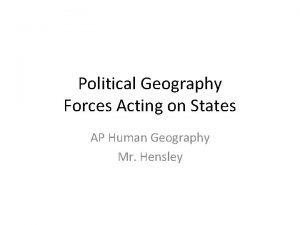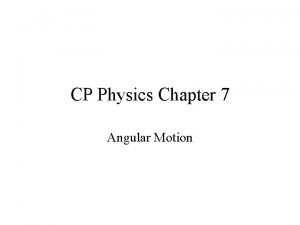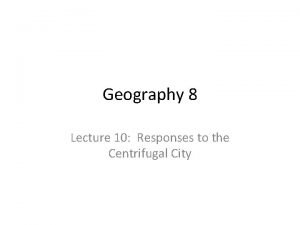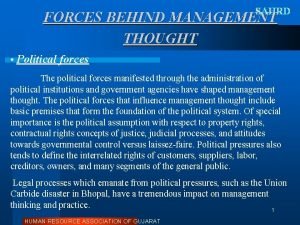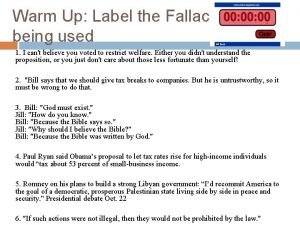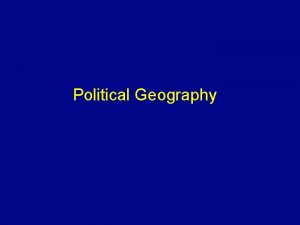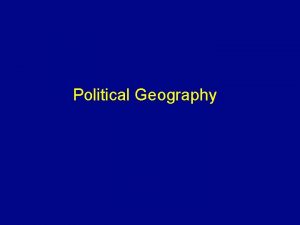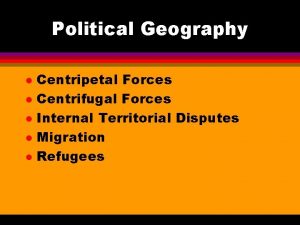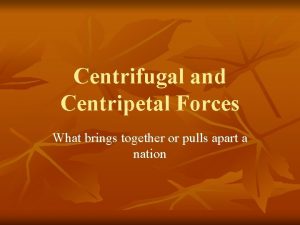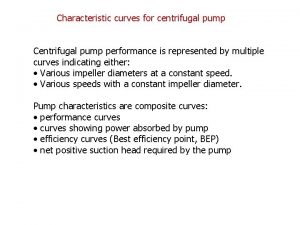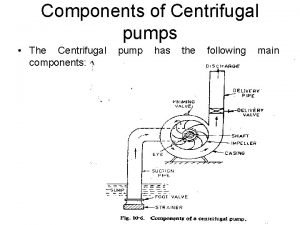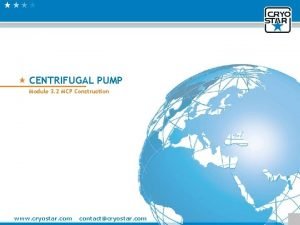Political Geography Centripetal and Centrifugal Forces Centrifugal Centripetal


















- Slides: 18

Political Geography Centripetal and Centrifugal Forces

Centrifugal Centripetal UNIFY People Hold together the social and political fabric of the state. DIVIDE People Tear apart the social and political fabric of the state. How would you classify these events: Centripetal or Centrifugal? Can you categorize them? (Political, Economic, Social, etc) 1. A booming economy 2. Ethnic conflict 3. Effective government social welfare programs 4. September 11 th 5. War 6. Natural Disaster 7. A strong and well-liked leader (Have you seen Invictus? )

Invictus

What is the difference between… Devolution The process whereby regions within a state demand gain political strength and growing autonomy at the expense of the central government Balkanization The process by which a state breaks down through conflicts among its ethnicities.

Centrifugal Forces and Devolution Movement of power from central government to regional governments within the state. Why? Ethnocultural (Czechoslovakia): We aren’t like you. Economic (Catalonia): Why should we pay for you? Spatial (Hawaii? ) Does Devolution = Independence Movement? Movement

Canada & Quebec

U. S. S. R.

Former Yugoslavia


What would happen if you had Centripetal Forces work beyond the State scale? What might bring people together beyond state identity? Think…Economic, Political, Military, Social Supranational Organizations

Why Do States Cooperate and Compete with Each Other? Political and military cooperation ◦ The United Nations (est. 1945) ◦ Regional military alliances Balance of power Post–World War II: NATO or the Warsaw Pact ◦ Other regional organizations OSEC (est. 1975) – organization on Security and cooperation in Europe OAS (est. 1962) – Organization of American States AU (est. 2002) – The African Union The Commonwealth – United Kingdom & former British colonies Economic cooperation (EU)

Exhibit A: U. N. Members

Exhibit “B” Economic and Military Alliances in Cold War Europe NATO and the European Union have expanded and accepted new members as the Warsaw Pact and COMECON have disintegrated.

Internationalism and Supranational Organizations


NAFTA

Arab League

Pacific Ocean What is The Law of the Sea? irc c. C cti Ar United States (Alaska) Arct ic C i rcle le Canada Russia North Pole Denmark (Greenland) Norway Iceland Arctic Circle Atlantic Ocean Canada Denmark Iceland Norway Russia United States Finland Sweden Unclaimed areas Internal waters The Convention on the Law of the Sea is an international treaty that sets environmental and commercial terms for use of the world's oceans. It protects the ocean from environmental degradation, establishes guidelines for businesses that depend on the sea for resources, defines maritime zones, and preserves freedom of navigation. 161 nations have signed and ratified this treaty. The United States is virtually alone among industrialized nations in not having done so, though the U. S. has voluntarily abided by the terms of the treaty since 1983. Law of the Sea Treaty
 Centrifugal force ap human geography
Centrifugal force ap human geography Centripetal forces ap human geography
Centripetal forces ap human geography Sovereignty ap human geography
Sovereignty ap human geography Centripetal force
Centripetal force 9 kg
9 kg How to write an frq for ap human geography
How to write an frq for ap human geography Ap human geography political geography test
Ap human geography political geography test Centripetal movement geography
Centripetal movement geography Centrifugal force ap human geography
Centrifugal force ap human geography Compact state geography definition
Compact state geography definition Political forces behind management thought
Political forces behind management thought Parallel force system example
Parallel force system example What are some contact forces and some noncontact forces
What are some contact forces and some noncontact forces Unbalanced force
Unbalanced force Is erosion a constructive force
Is erosion a constructive force Relationship between political science and geography
Relationship between political science and geography List six forces that shape political socialization
List six forces that shape political socialization The forces shown above are
The forces shown above are Intermolecular vs intramolecular
Intermolecular vs intramolecular

